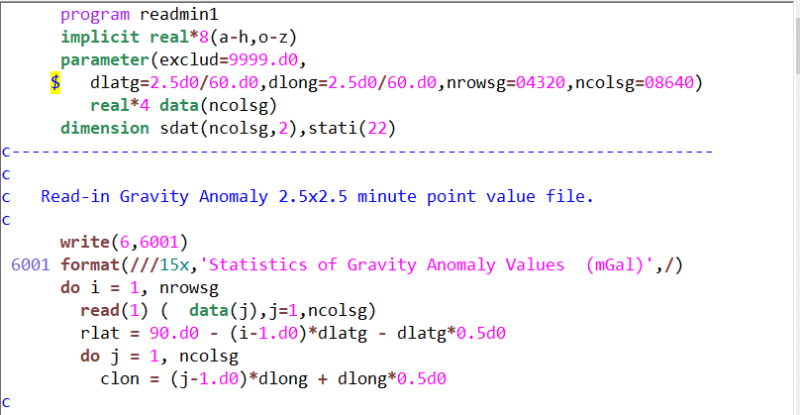c-----------------------------------------------------------------------
program readmin1
implicit real*8(a-h,o-z)
parameter(exclud=9999.d0,
$ dlatg=2.5d0/60.d0,dlong=2.5d0/60.d0,nrowsg=04320,ncolsg=08640)
real*4 data(ncolsg)
dimension sdat(ncolsg,2),stati(22)
c-----------------------------------------------------------------------
c
c Read-in Gravity Anomaly 2.5x2.5 minute point value file.
c
write(6,6001)
6001 format(///15x,'Statistics of Gravity Anomaly Values (mGal)',/)
do i = 1, nrowsg
read(1) ( data(j),j=1,ncolsg)
rlat = 90.d0 - (i-1.d0)*dlatg - dlatg*0.5d0
do j = 1, ncolsg
clon = (j-1.d0)*dlong + dlong*0.5d0
c
c Print a few values.
c
if(i.eq. 1.and.j.lt.20) then ! top row
write(6,6101) rlat,clon,data(j)
6101 format(5x,2f15.10,f15.5)
endif ! top row
sdat(j,1) = data(j)
sdat(j,2) = 1.d0
enddo ! j
call stats(90.d0,0.d0,i,dlatg,dlong,nrowsg,ncolsg,sdat,exclud,0,
$ stati)
enddo ! i
c-----------------------------------------------------------------------
c
c Read-in xi Deflection of Vertical 2.5x2.5 minute point value file.
c
write(6,6002)
6002 format(///15x,'Statistics of xi DOV Values (arc-second)',/)
do i = 1, nrowsg
read(2) ( data(j),j=1,ncolsg)
rlat = 90.d0 - (i-1.d0)*dlatg - dlatg*0.5d0
do j = 1, ncolsg
clon = (j-1.d0)*dlong + dlong*0.5d0
c
c Print a few values.
c
if(i.eq. 1.and.j.lt.20) then ! top row
write(6,6101) rlat,clon,data(j)
endif ! top row
sdat(j,1) = data(j)
sdat(j,2) = 1.d0
enddo ! j
call stats(90.d0,0.d0,i,dlatg,dlong,nrowsg,ncolsg,sdat,exclud,0,
$ stati)
enddo ! i
c-----------------------------------------------------------------------
c
c Read-in eta Deflection of Vertical 2.5x2.5 minute point value file.
c
write(6,6003)
6003 format(///15x,'Statistics of eta DOV Values (arc-second)',/)
do i = 1, nrowsg
read(3) ( data(j),j=1,ncolsg)
rlat = 90.d0 - (i-1.d0)*dlatg - dlatg*0.5d0
do j = 1, ncolsg
clon = (j-1.d0)*dlong + dlong*0.5d0
c
c Print a few values.
c
if(i.eq. 1.and.j.lt.20) then ! top row
write(6,6101) rlat,clon,data(j)
endif ! top row
sdat(j,1) = data(j)
sdat(j,2) = 1.d0
enddo ! j
call stats(90.d0,0.d0,i,dlatg,dlong,nrowsg,ncolsg,sdat,exclud,0,
$ stati)
enddo ! i
c-----------------------------------------------------------------------
stop
end
C
C
C
SUBROUTINE STATS(TOPLAT,WSTLON,I,GRDN,GRDE,NROWS,NCOLS,DATA,
$ EXCLUD,ISIG,STAT)
C-----------------------------------------------------------------------
IMPLICIT REAL*8(A-H,O-Z)
CHARACTER*20 DLABEL(14)
CHARACTER*20 SLABEL( 8)
DIMENSION DATA(NCOLS,2)
DOUBLE PRECISION DEXCLUD,DG,SD,STAT(22)
SAVE
DATA PI/3.14159265358979323846D+00/
DATA DLABEL/' Number of Values',' Percentage of Area',
$ ' Minimum Value',' Latitude of Minimum',
$ 'Longitude of Minimum',' Maximum Value',
$ ' Latitude of Maximum','Longitude of Maximum',
$ ' Arithmetic Mean',' Area-Weighted Mean',
$ ' Arithmetic RMS',' Area-Weighted RMS',
$ ' Arithmetic S.Dev.','Area-Weighted S.Dev.'/
DATA SLABEL/' Minimum Sigma',' Latitude of Minimum',
$ 'Longitude of Minimum',' Maximum Sigma',
$ ' Latitude of Maximum','Longitude of Maximum',
$ 'Arithmetic RMS Sigma','Area-wghtd RMS Sigma'/
C-----------------------------------------------------------------------
IF(I.EQ.1) THEN
DEXCLUD=EXCLUD
DTR=PI/180.D0
FOURPI=4.D0*PI
DPR=GRDN*DTR
DLR=GRDE*DTR
CAREA=2.D0*DLR*SIN(DPR/2.D0)
DO 10 K=1,22
STAT(K)=0.D0
10 CONTINUE
STAT( 3)= DEXCLUD
STAT( 6)=-DEXCLUD
STAT(15)= DEXCLUD
STAT(18)= 0.D0
ENDIF
C-----------------------------------------------------------------------
DLAT=TOPLAT-(I-1.D0)*GRDN-GRDN/2.D0
COLATC=(90.D0-DLAT)*DTR
AREA=CAREA*SIN(COLATC)
C-----------------------------------------------------------------------
DO 110 J=1,NCOLS
DLON=WSTLON+(J-1.D0)*GRDE+GRDE/2.D0
DG=DATA(J,1)
SD=DATA(J,2)
IF(DG.LT.DEXCLUD) THEN
C-----------------------------------------------------------------------
STAT( 1)=STAT( 1)+1.D0
STAT( 2)=STAT( 2)+AREA
IF(DG.LE.STAT( 3)) THEN
STAT( 3)=DG
STAT( 4)=DLAT
STAT( 5)=DLON
ENDIF
IF(DG.GE.STAT( 6)) THEN
STAT( 6)=DG
STAT( 7)=DLAT
STAT( 8)=DLON
ENDIF
STAT( 9)=STAT( 9)+DG
STAT(10)=STAT(10)+DG*AREA
STAT(11)=STAT(11)+DG**2
STAT(12)=STAT(12)+DG**2*AREA
IF(SD.LE.STAT(15)) THEN
STAT(15)=SD
STAT(16)=DLAT
STAT(17)=DLON
ENDIF
IF(SD.GE.STAT(18)) THEN
STAT(18)=SD
STAT(19)=DLAT
STAT(20)=DLON
ENDIF
STAT(21)=STAT(21)+SD**2
STAT(22)=STAT(22)+SD**2*AREA
C-----------------------------------------------------------------------
ENDIF
110 CONTINUE
C-----------------------------------------------------------------------
IF(I.NE.NROWS) RETURN
IF(STAT(1).GT.0.D0) THEN
STAT( 9)=STAT( 9)/STAT( 1)
STAT(10)=STAT(10)/STAT( 2)
STAT(11)=SQRT(STAT(11)/STAT( 1))
STAT(12)=SQRT(STAT(12)/STAT( 2))
STAT(13)=SQRT(STAT(11)**2-STAT( 9)**2)
STAT(14)=SQRT(STAT(12)**2-STAT(10)**2)
STAT(21)=SQRT(STAT(21)/STAT( 1))
STAT(22)=SQRT(STAT(22)/STAT( 2))
STAT( 2)=STAT( 2)/FOURPI*100.D0
ELSE
DO 120 J=3,22
STAT(J)=DEXCLUD
120 CONTINUE
ENDIF
C=======================================================================
NUM=INT(STAT(1))
WRITE(6,6001) DLABEL(1),NUM
6001 FORMAT(/5X,A20,3X,I11)
DO 210 K=2,14
WRITE(6,6002) DLABEL(K),STAT(K)
6002 FORMAT(5X,A20,3X,F15.3)
210 CONTINUE
WRITE(6,6003)
6003 FORMAT(' ')
IF(ISIG.EQ.1) THEN
DO 220 K=1,8
WRITE(6,6002) SLABEL(K),STAT(K+14)
220 CONTINUE
ENDIF
C=======================================================================
RETURN
END


![[smile] [smile] [smile]](/data/assets/smilies/smile.gif)